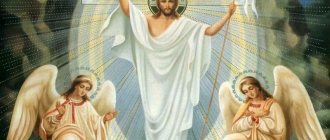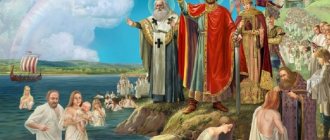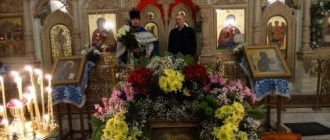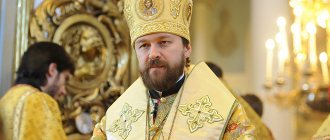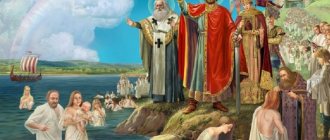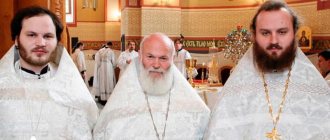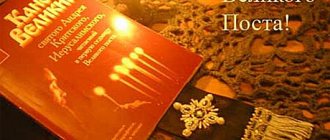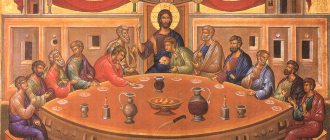Stoglav
, a collection containing a description of the acts and resolutions of the council of 1551. This name of the collection was established only in scientific literature.
Writers of the 17th century they called it “Stoglavnik”
, due to the fact that it is divided into 100 chapters. Hence the cathedral itself in 1551 is usually called Stoglavy.
Stoglav's decrees provide a wealth of material for studying the cultural life of Moscow society in the mid-16th century, and are of great practical importance. Stoglav serves as one of the main strongholds for the Old Believers in their polemics with representatives of the Russian Orthodox Church.
The most important, but also the most controversial question is: was Stoglav an official monument, did it have canonical significance in the form that has survived to this day, or not? The solution to this issue is made difficult by the fact that almost no news has reached us about the order of the meetings of the council and the development of its resolutions.
Only the news has survived that the clerks were to present reports to the cathedral on the decrees of the former princes; in Stoglav itself it is said that all the royal proposals and questions and answers to them were “consigned to the scriptures” and were sent in written form to the Trinity-Sergius Monastery for viewing by the former Metropolitan. Joasaph and other clergy who were there, who, having examined the “royal and hierarchical code,” joined this “conciliar code” (chap. 99) and made only a few notes to it, which were also included in the Stoglav (chap. 100).
Indications of the recording of conciliar decisions and their names are confirmed by a number of official documents. So, in the period from May 17, 1551 to 1560. up to 12 charters and acts were issued, which carried out new measures in the order of church administration and court according to the “new cathedral code” or simply “according to the cathedral code,” sometimes also called the Metropolitan’s cathedral code. Macarius, or by the conciliar code of the tsar and the metropolitan together, or, finally, by the “royal council and the conciliar code.” Once it was prescribed to “fix everything because it is written in the conciliar code.” Moreover, quite extensive extracts from cathedral decrees, under the name of orders or order lists, were sent by the metropolitan and bishops to the cities and monasteries of the dioceses subordinate to them.
Until now, two types of such orders are known (three orders for each type): orders of one type were intended to guide the diocesan clergy, the other - for monasteries. In the letter of the metropolitan, in which the order was sent to the Simonov Monastery in July 1551, a postscript was preserved, from which it is clear that with the same letters it was ordered to send out to other monasteries “a teaching, chapters from the same cathedral books to be copied out.”
A similar indication of the existence of a conciliar book was preserved in the record of the acts of the church council of 1553, at which the tsar with the metropolitan and the entire council discussed “about the previous conciliar code, about the various affairs and rites of the church, and according to the book of the conciliar members, which matters have been corrected and who have not yet corrected themselves.”
Finally, it is known that the Great Moscow Council of 1667 was about the Stoglav Cathedral “and that it was written about the sign of the honorable cross, that is, about the folding of two fingers, and about the special hallelujah, and about other things that were written foolishly, in simplicity and ignorance in the book of Stoglav,” and about oath in observance of the cathedral rules) decided that “that council is not a cathedral, and an oath is not an oath, and we are imputed to nothing, as if it never happened.”
The totality of all this official evidence leads some researchers to the belief that the resolutions of the council of 1551 received legislative force in the code known as Stoglav (Golubinsky).
The original cathedral book with the signatures of the cathedral members has not been preserved or has not yet been found. Stoglav's lists of the 16th and 17th centuries. differ significantly from each other; Between them there are three editions: lengthy, medium and short. Which of them should be considered the main one?
Only regarding the middle one was there a consensus that it arose in the 17th century. Regarding the other two, opinions differ: some, including defenders of Stoglav’s officiality, consider the short version to be the main one; others convincingly prove the groundlessness of this point of view and recognize the lengthy lists as authentic.
Detailed observations of the composition of Stoglav lead to the conclusion that “in Stoglav we have only an extract from the conciliar acts; it preserves only a few traces of the original materials that served as the basis for the council's decisions. This collection could and should have served as a historical basis and material for such purely legislative monuments as royal and conciliar orders and charters” (I. Zhdanov).
Stoglav's sources were, first of all, the canonical rules and laws of the Byzantine emperors; some of them are placed in Stoglav in extensive extracts. The same should be said about church-legal monuments of Russian origin, such as church statutes, messages from church representatives, decrees of previous councils, etc.
Not all of these excerpts and references are distinguished by canonical accuracy, which was already noted by the council of 1667, which indicated that Stoglav’s inaccuracies arose from the unfamiliarity of the members of the council of 1551 with Greek and ancient charatean Slavic books.
It is difficult to admit that these sources were collected as needed after the opening of the cathedral; much should have been prepared earlier. Both in the selection of material and in the formulation of the questions themselves, the stormy currents of social thought that have worried Moscow society since the emergence of the Judaizer heresy could not but be reflected.
News and events of the Russian Historical Society
Information about the material Published: June 05, 2020
We continue the series of publications about documents included in the project “100 Rarities of Russian Statehood”, posted on the website of the Federal Archival Agency.
Today we will talk about a collection of decisions of the church council, which for more than 100 years was the main code that determined church life and the relationship of the church with the state and the laity - Stoglav of 1551. It was the first to describe in detail the Russian church judicial system. The Stoglavy Cathedral became one of the largest cathedrals in the history of the Russian Orthodox Church. Its meetings were held in Moscow in the royal chambers, and Tsar Ivan IV, Metropolitan Macarius, bishops, clergy, princes, boyars and military personnel took part in it. The convocation of the Council was dictated by the unification of the Russian state, the actions of the Elected Rada and the Zemsky Sobor, the adoption of the Code of Law of 1550, the activities of Metropolitan Macarius of Moscow to strengthen the conciliar principle in the Church, etc.
The Council everywhere established the institution of elected priestly elders and tenth priests to control the performance of divine services, the correction of books and icons, the safety of church property, and the behavior of the clergy and laity. The sale of church and monastery lands and real estate, the sale of burial places, the construction of churches next to neglected old ones, the removal of utensils from churches, the collection of fees for tonsure into monasticism and ordination to the priesthood, as well as the extortion of money for performing religious services were prohibited. Worship and rituals were unified (singing hallelujah, making the sign of the cross with two fingers). The management and spiritual guidance of monasteries was entrusted to the abbot, treasurer, cellarer and cathedral elders. The council forbade the founding of deserts without the blessing of the bishop, and the abbots forbade collecting gifts from parishioners. The age and criteria for ordination to the priesthood, the procedure for electing archimandrites and abbots were determined. Particular attention was paid to the discipline of clergy and laity. A number of decrees affected marriage and family relations, charity, superstitions, pagan rituals, the teachings of “false prophets,” gambling, buffoonery, forbidden books, etc.
The text of Stoglav, who enjoyed unquestionable authority, was widely disseminated: about 180 copies of it are known, as well as fragments in various messages. Some decisions of the Stoglavy Council, adopted “unreasonably, simplicity and ignorance” (primarily the double hallelujah and double fingers), were condemned at the Moscow Council of 1666–1667. Subsequently, Stoglav became the central subject of controversy between the official Church and the followers of the Old Believers; its authenticity and significance were questioned. After the publication of the Spiritual Regulations in 1721, the decisions of the Stoglavy Council lost their significance.
Today Stoglav is stored in the Russian State Archive of Ancient Acts.
In addition to Stoglav, the decisions of the Council are also known in letters that were sent to the localities of the Moscow state on behalf of the tsar and bishops. In particular, on the website of the Russian National Library you can familiarize yourself with the contents of the Tsar’s speeches and questions to the Stoglavy Council (from the collection of Evfimy Turkov, 16th century), copies of the mandate letter of Metropolitan Macarius to Vladimir dated November 10, 1552, copies of the Tsar’s mandate letter to Volok from 1552, royal questions and conciliar answers about various church rites (Stoglav) (60–70s of the 16th century), etc.
Text: Vera Marunova
Based on materials from the project “100 Rarities of Russian Statehood”, “The Great Russian Encyclopedia” and the Russian National Library.
What is the Stoglavy Cathedral
The event was the second Zemsky Sobor in Russian history. This was the name of the state body of the estate-representative monarchy that existed in Russia in the 16th-17th centuries.
In total, from 1549 to 1684, such councils were convened from 45 to 60 times.
However, their exact number cannot be established due to the small number of sources and written monuments of the initial period. They discussed mainly issues of foreign and domestic policy, tax collection rules and other legislative acts.
Collection of council decisions
The Conciliar, or the Royal and Hierarchical Code, is the name given to the collection of resolutions of the cathedral in the text of the document itself. And only towards the end of the 16th century, the more familiar name to us was established - Stoglav.
He collected and systematized not only all the norms of church law of that time, but also many secular laws.
Financial questions
The collection of duties ceases to be the business of bishops' officials and is transferred to the grassroots level. For this purpose, there is now an elective position of priestly elders - assistants to the local bishop in economic, fiscal and supervisory affairs. Headmen existed before, but from now on they are elected everywhere.
It was the material and monetary issue that turned out to be the aspect where the benefits of religious institutions were reduced to the greatest extent. Thus, the church banned usury in cash and in kind, as well as receiving land and real estate as a gift without royal permission. Sanctions are imposed for violations.
The state begins to persecute people hiding in monasteries from paying taxes under plausible pretexts. Such violators had to be found, expelled back, returned to work and performing duties according to their class affiliation.
Morality of the clergy
Unrest and weak discipline in the ranks of the clergy were officially recognized. The approval of the position of elders was also intended to improve supervision of deanery and the proper administration of services. The ten priests in rural areas, also elected, were subordinate to the elders.
The resolution condemns uncontrolled begging, which sometimes involved the collection of alms by monks. An important innovation was the creation of so-called “double” monasteries. From now on, monastics of both sexes could live in the same monastery, but subject to strict separation of men and women, adherence to the rules and maintenance of chastity.
Immorality of the laity
Attention was also paid to correcting the morals prevailing among the masses.
There is evidence that church ministers wrote to the king complaining about the still remaining remnants of pagan cults and pre-Christian customs. A careless attitude towards services, a lack of reverence among believers, and even sorcery at prosphora - all this, according to the text of the code, became commonplace in Russian life of that time. Western influence led to a certain spread of fashion for shaving beards, which clearly ran counter to the instructions of the church and ancient norms of piety. This was prohibited under threat of fine or excommunication and was almost equated with “heresy” and “Latinism.” Measures were taken against witchcraft, buffoonery, gambling and some other folk amusements.
Worship and religion
Thanks to the influence of Metropolitan Macarius, liturgical and religious issues were also brought up for discussion, on which at that time a lot of unrest had also accumulated.
Therefore, the following norms of Orthodox rituals are officially approved:
- double-fingered sign of the cross;
- double hallelujah;
- baptism through complete triple immersion;
- a ban on priests passing through the Royal Doors without liturgical vestments (robes and stoles);
- the presence of an antimension with a particle of relics as a prerequisite for the sanctification of the church;
- service after the bell ringing;
- the performance of worship by a priest only in vestments.
Family and marriage
The marriage age is set at 15 for boys and at 12 for girls.
Only the first marriage was allowed to be crowned; the second was now only allowed to be blessed, but with the imposition of penance for 1-2 years; the third was not blessed at all and was punishable by excommunication for 5 years. The fourth marriage was not recognized as such at all; it was considered a crime, fornication and a “pig’s life.”
Church court
The Code divides the secular and ecclesiastical judicial systems into two separate branches. The so-called “non-judgmental letters” were abolished - monasteries and parish clergy from now on became subject to the jurisdiction of the bishops of their diocese.
Clergymen could no longer be brought to state court.
However, the innovation encountered difficulties, because it was not possible to immediately change the system. A compromise solution is adopted in the form of the right of priests to represent their interests in a secular court through their own elected representatives. However, their role in legal proceedings was never clearly defined.
Church land ownership
The problem of church land and other property turned out to be perhaps the most acute and pressing of those described in the text of the code. In this regard, the clergy were divided into two rival factions. Non-covetous people were a minority, but were supported by the Tsar's Selected Rada, including the priest Sylvester, a close associate of Ivan the Terrible. The Josephites made up the majority and numerically dominated among the participants in the council.
Non-acquisitive people professed an ascetic approach and proposed limiting monastic land ownership, allowing for the seizure of land in favor of the state. Their opponents, the Josephites, promoted the idea of monasteries as strong institutions of feudal society, owning vast lands and controlling food supplies to provide for the population in lean years.
The topic of land ownership turned out to be a sensitive one and was not included in the text of the code, although it was raised in the discussion.
However, a chapter published later as an addition, known as “The Verdict on Patrimonies,” speaks of the following ways to resolve the land issue:
- Bishops and monasteries are prohibited from acquiring land without royal permission.
- It is equally prohibited to give lands to monasteries without reporting to the king.
- At the same time, it is allowed to donate plots of land “for the soul’s remembrance” only if the conditions and procedure for their redemption by the relatives of the person who made the will are established.
- The above laws did not have retroactive effect and did not apply to transactions and agreements completed earlier.
- From now on, in case of violations, the patrimony must be confiscated in favor of the state without any compensation to any of the parties.

